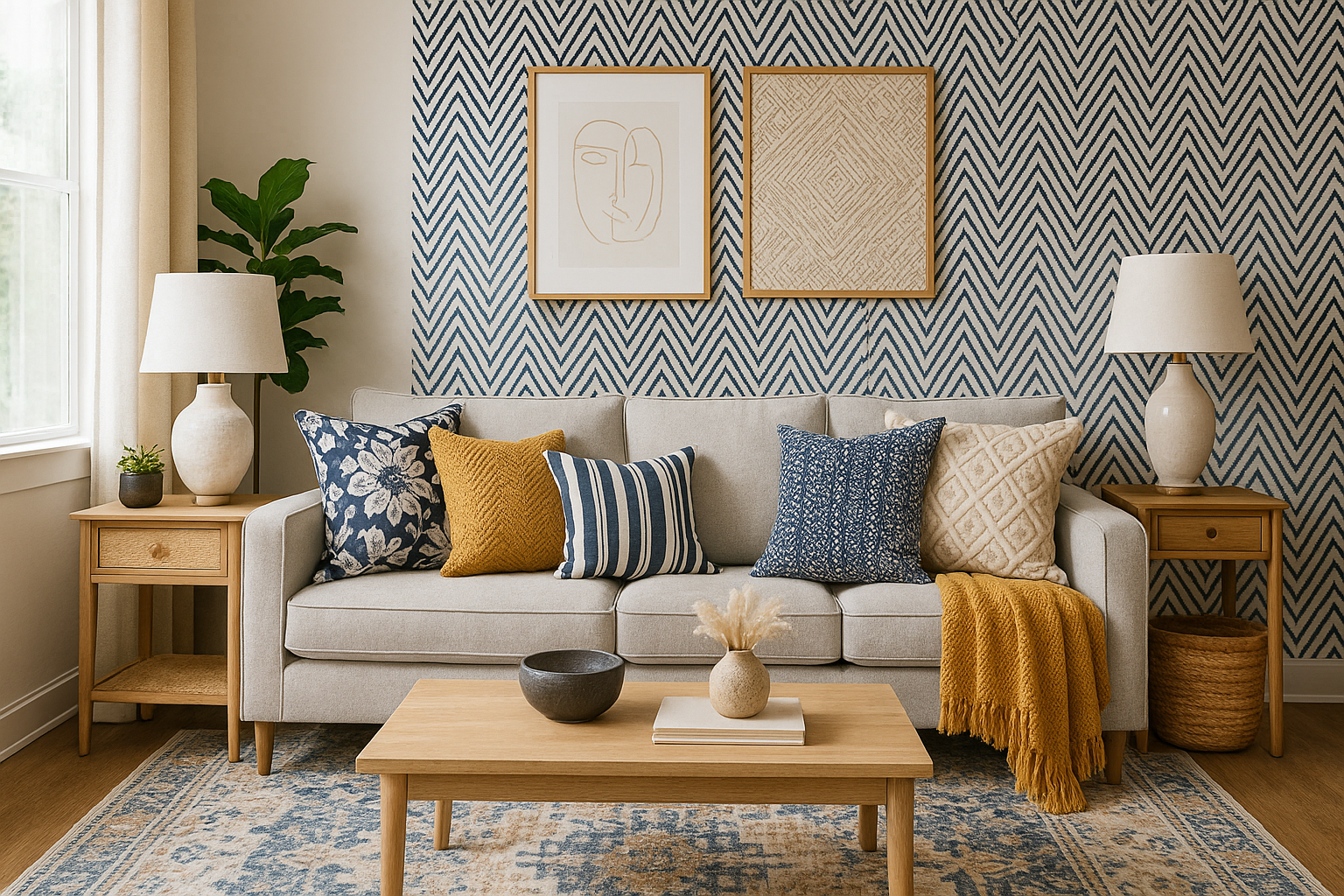Mixing patterns and textures is one of the best ways to create a visually rich and personalized home — but it’s also one of the trickiest. When done right, it adds depth, warmth, and character. When done poorly, it can feel chaotic and mismatched.
In this guide, you’ll learn how to confidently combine patterns and textures to make your space dynamic and stylish — without overwhelming the eye.
Why Patterns and Textures Matter
Using a variety of patterns and textures:
- Adds visual interest to neutral or minimalist rooms
- Creates layers that make a room feel more lived-in and cozy
- Helps express your personality through decor
- Prevents a space from looking flat or one-dimensional
Even small changes — like a velvet pillow or a striped rug — can transform the feel of a room.
1. Start with a Neutral Base
If you’re new to mixing patterns, the safest place to start is with neutral walls, floors, and large furniture pieces.
- Think of your sofa, rug, or bedding as a blank canvas.
- Use beige, white, gray, or soft tones to keep things balanced.
- This lets your patterns and textures pop without clashing.
Once the base is set, you can layer in bold pieces with more confidence.
2. Choose a Color Palette and Stick to It
Having a cohesive color scheme keeps mixed patterns from looking chaotic.
- Choose 2–3 main colors and 1–2 accent colors.
- Make sure all patterns fall within this palette.
- Vary intensity (some soft, some bold) to add contrast.
Example: navy, white, and mustard yellow can carry across stripes, florals, and solids in perfect harmony.
3. Mix Different Pattern Scales
The trick to mixing patterns successfully? Vary the scale.
- Combine large-scale patterns (like oversized florals) with medium (like geometric prints) and small-scale (like polka dots or fine stripes).
- Avoid putting similar-sized patterns side by side — they’ll compete for attention.
This variation creates depth and movement.
4. Use Patterns with Shared Colors
Even wildly different patterns can work together when they share at least one color.
- A floral pillow and a checkered throw might look great together if they both include sage green.
- Look for colors that repeat across your patterned pieces to tie them together visually.
This creates cohesion even with bold designs.
5. Anchor the Space with Solids
Solid-colored pieces act as visual rest zones between patterns.
- Use solid throw pillows, curtains, rugs, or bedding to balance bold combinations.
- Solid colors in textured fabrics (like velvet, linen, or leather) can still add richness without clashing.
Too many patterns without solids can feel overwhelming.
6. Introduce Texture for Depth
Textures create tactile variety, making a space feel cozy and inviting.
- Mix smooth (glass, silk) with rough (burlap, wool).
- Combine soft (velvet, faux fur) with hard (wood, metal).
- Add woven baskets, knitted throws, leather accents, or rattan furniture.
Texture can be especially powerful in neutral rooms, where visual variety comes from feel rather than color.
7. Layer Patterns in Layers of the Room
Spread patterns throughout the room to create balance.
- Use a patterned rug on the floor.
- Layer printed pillows or throws on the sofa or bed.
- Add patterned curtains, artwork, or lampshades.
- Include textured vases, woven planters, or ceramic decor.
The eye should travel around the room and pick up patterns in different zones.
8. Limit the Number of Competing Patterns
More isn’t always better. Stick to 2 or 3 patterns per room for balance.
- Example combo: striped rug + floral pillows + solid textured sofa
- Or: plaid curtains + abstract art + neutral bedding
You can always add more later, but it’s better to build slowly than start with too much.
9. Mix Pattern Types for Visual Interest
Combining different types of patterns keeps the look dynamic.
- Try pairing organic patterns (like florals or nature motifs) with structured ones (like stripes or grids).
- Mix curved designs (like circles or paisley) with angular ones (like chevron or diamonds).
- Combine classic prints (plaid, houndstooth) with modern styles (bold abstracts, line art).
This contrast keeps things interesting without clashing.
10. Don’t Forget the Ceilings and Floors
Patterns and textures aren’t just for eye-level surfaces.
- Add a patterned rug or floor tile to ground the room.
- Use textured ceiling lights or even patterned wallpaper on the ceiling for a bold twist.
- Wooden beams, beadboard, or wallpapered ceilings can add unexpected interest.
These often-forgotten areas can become statement features.
Final Thought: Balance Is Everything
Mixing patterns and textures is a design skill that gets easier the more you experiment. The key is balance — in scale, color, texture, and placement. Don’t be afraid to play around, trust your instincts, and most importantly, have fun with it.
A well-layered room feels collected, not chaotic — and shows the world exactly who you are.
